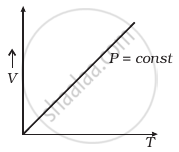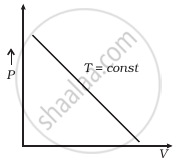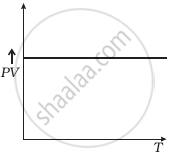Advertisements
Advertisements
प्रश्न
Oxygen is filled in a closed metal jar of volume 1.0 × 10−3 m3 at a pressure of 1.5 × 105Pa and temperature 400 K. The jar has a small leak in it. The atmospheric pressure is 1.0 × 105 Pa and the atmospheric temperature is 300 K. Find the mass of the gas that leaks out by the time the pressure and the temperature inside the jar equalise with the surrounding.
उत्तर
Here,
V1 = 1.0 × 10-3 m3
T1 = 400K
P1 = 1.5 × 105 Pa
P2 = 1.0 × 105 Pa
T2 = 300
M = 32 g
Number of moles in the jar before \[n_1 =\frac{P_1 V_1}{R T_1} \]
Volume of the gas when pressure becomes equal to external pressure is given by
\[ \frac{P_1 V_1}{T_1} = \frac{P_2 V_2}{T_2} \]
\[ \Rightarrow V_2 = \frac{P_1 V_1 T_2}{P_2 T_1} \]
\[ \Rightarrow V_2 = \frac{1.5 \times {10}^5 \times 1.0 \times {10}^{-3} \times 300}{1.0 \times {10}^5 \times 400} = 1.125 \times {10}^{-3 }\]
Net volume of leaked gas = V2 - V1
= 1.125 × 10-3 - 1.0 × 10-3
= 1.25 × 10-4 m3
Let n2 be the number of moles of leaked gas. Applying equation of state on this amount of gas, we get
\[ n_2 = \frac{P_2 V_2}{R T_2} = \frac{1.0 \times {10}^5 \times 1.25 \times {10}^{-4}}{8.3 \times 300} = 0.005 \]
Mass of leaked gas = 32 × 0.005 = 0.16 g
APPEARS IN
संबंधित प्रश्न
Molar volume is the volume occupied by 1 mol of any (ideal) gas at standard temperature and pressure (STP: 1 atmospheric pressure, 0 °C). Show that it is 22.4 litres
An oxygen cylinder of volume 30 litres has an initial gauge pressure of 15 atm and a temperature of 27 °C. After some oxygen is withdrawn from the cylinder, the gauge pressure drops to 11 atm and its temperature drops to 17 °C. Estimate the mass of oxygen taken out of the cylinder (R = 8.31 J mol–1 K–1, molecular mass of O2 = 32 u)
Three vessels of equal capacity have gases at the same temperature and pressure. The first vessel contains neon (monatomic), the second contains chlorine (diatomic), and the third contains uranium hexafluoride (polyatomic).
Is the root mean square speed of molecules the same in the three cases? If not, in which case is vrms the largest?
At what temperature is the root mean square speed of an atom in an argon gas cylinder equal to the rms speed of a helium gas atom at – 20 °C? (atomic mass of Ar = 39.9 u, of He = 4.0 u).
50 m3 of saturated vapour is cooled down from 30°C to 20°C. Find the mass of the water condensed. The absolute humidity of saturated water vapour is 30 g m−3 at 30°C and 16 g m−3 at 20°C.
Give reasons for the following:
Gas fills the vessel completely in which it is kept.
Choose the correct answer:
The graph of PV vs P for gas is
Correct the following statement:
0°C is equal to zero Kelvin.
The average energy per molecule is proportional to ______
Show that for monoatomic gas the ratio of the two specific heats is 5:3.
Show that for diatomic gas the ratio of the two specific heats is 7:5.
Gases exert pressure on the walls of the container because the gas molecules ______
Three vessels of equal capacity have gases at the same temperature and pressure. The first vessel contains neon (monatomic), the second contains chlorine (diatomic), and the third contains uranium hexafluoride (polyatomic).
Do the vessels contain an equal number of respective molecules?
Which of the following diagrams (Figure) depicts ideal gas behaviour?
 (a) |
 (b) |
 (c) |
 (d) |
The volume V of an enclosure contains a mixture of three gases, 16 g of oxygen, 28 g of nitrogen and 44 g of carbon dioxide at absolute temperature T. Consider R as universal gas constant. The pressure of the mixture of gases is ______.
Cooking gas containers are kept in a lorry moving with uniform speed. The temperature of the gas molecules inside will ______.
At room temperature, a diatomic gas is found to have an r.m.s. speed of 1930 ms-1. The gas is ______.
Two tanks of equal volume contain equal mass of oxygen and nitrogen at 127°C. Find the ratio of pressure in two tanks.
